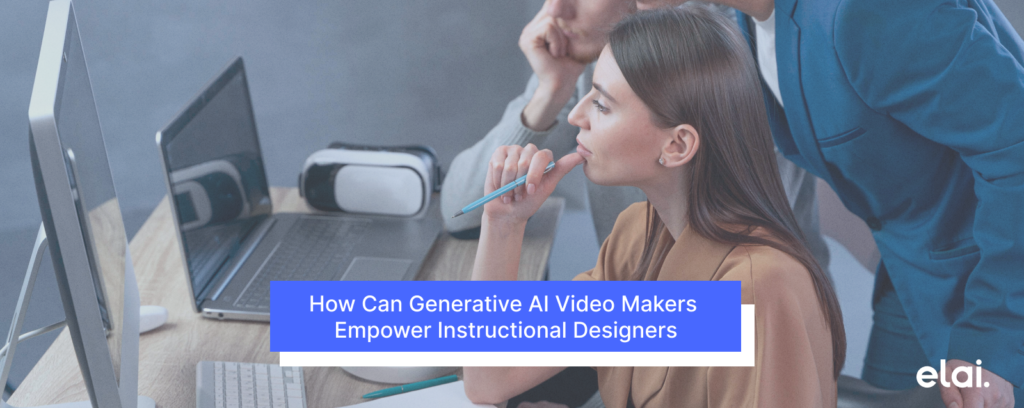Hey, pals and gals! How much do you know about instructional design? Well, this is a methodical process within the realm of education and training. It encompasses crafting and optimizing learning experiences to ensure maximum effectiveness.
Over the years, technology has played a fundamental role in shaping instructional design, evolving from the early use of projectors in classrooms to the integration of multimedia in e-learning platforms.
But the story doesn’t end there—here’s where things get even more fascinating. AI is a true game-changer that brings transformative potential to the field of instructional design. AI offers an array of innovative solutions and exciting opportunities, revolutionizing the way we create and deliver educational content.
In this exploration, we’ll journey into the ways AI is reshaping the face of instructional design, opening up exciting new horizons for educators and learners alike.

AI Contribution to Instructional Design Videos in Education
As an instructional designer, you undoubtedly recognize and appreciate the power of video content. Perhaps you’ve even crafted courses that revolve around captivating lecture-generative AI videos .
Now, when it comes to enriching the learning experience, let’s talk about the potential that selected educational videos hold. These videos, aligned with the curriculum and leveraging proven pedagogical methods, have the ability to elevate student outcomes to new heights.
The realm of incorporating video content into course design is brimming with creativity and effectiveness. In this regard, allow us to unveil four captivating video approaches that will animate your AI instructional designer toolkit.
1. Make your class more interactive by flipping it
If you incorporate a chat, forum, or live virtual class, you can take it to the next level by including educational videos. These videos will act as the catalyst for discussions among your students.
Even a short, informative clip has the potential to ignite exciting conversations and get your students thinking. The best part? Your students can watch these videos at their own convenience and actively participate in class discussions or engage in group chats and forums.
To make it even more stimulating, you can guide these conversations with thought-provoking questions that delve into the key concepts of your course.
Elai’s interactive Q&A videos aim to provide comprehensive answers to all your burning questions and help you grasp new concepts easily.
Elai.io platform provides real-time collaboration capabilities, making endless email chains and version control issues a thing of the past. With Elai.io, all members of your team can seamlessly collaborate on a single presentation without missing a beat.
At Elai.io, we take collaborative workspaces to the next level. Your entire team can access the video, making collaboration and edits effortless.
2. Effectively using "how to" videos for instructional purposes
These instructional design videos serve as a conduit to guide people through acquiring new skills.
For instance, instructional designers can employ screencast videos to effectively demonstrate the use of diverse computer programs or applications. Moreover, “how to” videos offering step-by-step guidance on solving equations or conducting experiments can greatly benefit math and science courses.
We understand that sometimes viewers struggle to grasp the main message of a video. Here’s where subtitles come to the rescue! By simply toggling the Subtitles switch in the Elai builder, your creation will be bestowed with the written words upon rendering. Once your video is ready, you can download it, embed it, or unleash it upon the world directly through the Elai builder.
To further enhance your content, use speech marks, connecting specific text blocks or elements with the corresponding words in the speech field.
3. Enhancing educational videos for maximum engagement
These videos are like stepping into a classroom. Some teachers even record their own classes, allowing absent students to catch up at home. Not to mention, students can use these recordings to review sections or topics at their own convenience.
However, not all lecture videos are created equal when it comes to engagement. Luckily, there are steps instructors can take to make their videos more captivating. Check out these important considerations:
- Shorter videos work wonders for maintaining attention. Aim for around six minutes or less – the sweet spot for maximum viewer engagement. Students are more likely to watch videos of this length all the way through.
- Let the videos feel conversational, like the speaker is personally addressing the students.
- Offer students control over the video playback, allowing them to rewind, pause, and adjust the speed to their liking.
- Want to take things up a notch? Enhance the lecture with in-video supports such as animations, headings, or images.
With Elai, you can incorporate animations, voice overs, eye-catching fonts, and even music to truly captivate your audience. Create custom templates that include relevant colors, and watch your videos come to life in style!
And remember, whenever you find yourself needing some assistance, AI is always ready to lend a helping hand with its editing capabilities.
Oh, and don’t forget to spice things up by incorporating listener avatars! This interactive approach not only improves information absorption but also ensures the learning experience leaves a lasting mark on students’ memories.
4. Learning with history and role-playing
When delving into the world of history or realms of literature set in distant lands, educational videos emerge as invaluable tools. For instance, when designing a course that unravels the mysteries of WWII, weaving in a series of educational video clips from that era can truly enrich the learning experience.
These videos amaze students, plunging them headfirst into the historical and social events while acquainting them with key figures of the time.
Similarly, role-playing videos breathe life into training sessions, offering real-world scenarios and the secrets behind effective strategies. Picture a role-playing video demonstrating how a doctor unveils a diagnosis to a patient, guiding other medical professionals and imparting the art of body language, tone of voice, and more.
To unlock a gateway to another epoch, consider the profound influence of languages and accents. Moreover, accents serve as powerful conduits for a global audience, delivering localized content to viewers of various linguistic backgrounds.
With Elai.io’s video generator, you can access a wide variety of accents and dialects. This powerful tool allows you to incorporate diversity into your video projects, ensuring that your content resonates with viewers from all over.
Enhancing Employee Training Initiatives with AI
AI has integrated itself into our daily lives, unveiling algorithms that were once concealed but are now within reach of the public. The emergence of AI-driven systems brings an opportunity to streamline tasks and amplify the effectiveness of professionals, including Learning and Development experts and training consultants.
By using AI tools for learning design, the work cycle of instructional design in education teams can be elevated, resulting in heightened efficiency and focus.
The onboarding process is a breeze with AI-generated videos, ensuring easy information updates and captivating knowledge base videos that employees find more engaging than plain text.
Amidst lingering concerns about AI deployment, the potential for collaboration with this technology to optimize the learning design process is truly breathtaking. The goal of leveraging AI-driven systems should be to elevate outcomes and simplify the processes we depend on. The values we uphold regarding AI should mirror those we hold for any technology – purpose-driven, precise, and transparent application.
With these aspirations in mind, now is the moment to embark on an exploration of the possibilities that AI offers to L&D, fueling advancements in the design and delivery of employee training and developmental initiatives.
AI for Learning Design: 3 Ways to Get Started
1. Content crafting
Content creation using generative AI, like ChatGPT, offers vast possibilities. It can assist instructional professionals in developing learning frameworks, conducting research, and generating course content.
Chatbots serve as personalized assistants, providing context, summaries, and prompt-based responses. Leveraging AI allows instructional professionals to focus on refining activities while ensuring accuracy and addressing learner needs.
Machine intelligence enhances employee training and development, boosting efficiency and content quality. However, it’s important to recognize that AI has its limitations, including algorithmic biases and potential errors. AI facilitates the creative process rather than replacing it.
Introducing Elai.io, a powerful tool with GPT enhancements. It simplifies script crafting, resulting in exciting video scripts. Whether it’s educational or instructional design videos, Elai.io, powered by Chat GPT, creates ready-made scripts that captivate your audience.
Additionally, you have the flexibility to customize slides generated by the GPT using a wide array of pre-designed templates.
2. Graphics Creation
For certain projects, instructional professionals often find themselves in need of unique graphics or specific designs that are either unavailable online or too expensive to create from scratch. This is where the graphic design AI systems come into play, revolutionizing the learning design process.
With tools like Adobe Firefly and Dalle2, graphic programs endowed with artificial intelligence can generate prototype graphics and assist in refining existing visual designs. By integrating AI into the learning design workflow, professionals can reclaim valuable time to delve into truly innovative and creative aspects of their work.
Furthermore, AI serves as a framework when the L&D team lacks the bandwidth for graphics enhancement. It acts as a fundamental tool, elevating and enhancing the overall quality of the training materials.
3. Audio creation
Alongside graphic and content generation, audio AI serves as a tool for enriching your learning design process. Enter the realm of text-to-speech (TTS) technology, like Elai.io software, which has long been embraced by industry experts. It grants you the power to transform written instructional content, scripts into captivating audio and video formats.
Intriguingly, the integration of multimedia elements into learning design aids in crafting prototype content and enhancing the accessibility of the learning trip.
Elai.io is a platform that presents a diverse array of voices, artfully tailored to suit various content types and audience preferences. With different accents, languages, and tones at your disposal, the perfect voice awaits your selection.
While Elai mesmerizes with its mimicry prowess, it embodies the art of organic outcomes. Immerse yourself in the realms of pronunciation and intonation, allowing the generated voice to mirror the desired accent.
Amplify your audio experience with a voice-over upload feature! Simply upload your own audio recording, and watch as the avatar syncs with your voice, creating an exciting synchronization.

Comprehensive Courses with Embedded Educational Videos
Instructional designers craft each element included in a course or lesson. Educational videos, serving as vital instruments in imparting concepts and information, play a pivotal role within a broader framework.
To effectively inject intrigue into educational videos, instructional designers can employ an array of strategies:
- Fascinate students by posing a stimulating and thought-provoking question that sets the stage before they delve into the video.
- Following the video, enhance comprehension by introducing a series of intriguing questions, a homework assignment, or a discussion designed to deepen understanding.
- Empower students and showcase their individuality by creating their own video responses, such as parodies, “how-to” videos, or reactions. Further, enrich the learning experience by organizing peer reviews of each other’s work.
- Infuse interactive elements throughout the video, such as pause-and-answer questions. For an added twist, embedding multiple-choice questions below the video on the same page could be game-changing.
- Prompt students to harness educational videos as a valuable resource while constructing a report or essay on the topic at hand.
- Lastly, when incorporating educational videos into your courses, ensure universal accessibility, granting every student an equal opportunity to partake in the learning journey.
By implementing these approaches, instructional designers can transform educational videos into informative masterpieces that engage learners.
Conclusion
AI’s ever-evolving role in instructional design is nothing short of transformative. Its ability to personalize learning, accurately anticipate needs, automate tedious tasks, and provide immediate feedback holds immense potential for revolutionizing educational outcomes.
The careful, informed, and innovative integration of AI by instructional designers has the power to elevate educational experiences to new heights, all while ensuring the learner remains at the center, with technology acting as an enhancement rather than overshadowing the human element of learning.
In today’s ever-changing world, the inclusion of videos in education has shifted from being a mere luxury to an absolute necessity. Videos empower learners, accommodating a plethora of learning styles, and offering a dynamic platform for the dissemination of knowledge.
Enter Elai.io, a video creation tool that unveils a realm of diverse possibilities for instructional designers. Armed with a rich array of features such as seamless video editing, interactive elements, and designed templates tailored specifically for training and e-learning, this visionary toolkit streamlines the video production workflow, ensuring that even designers without extensive video editing experience can bring their creative visions to life.

